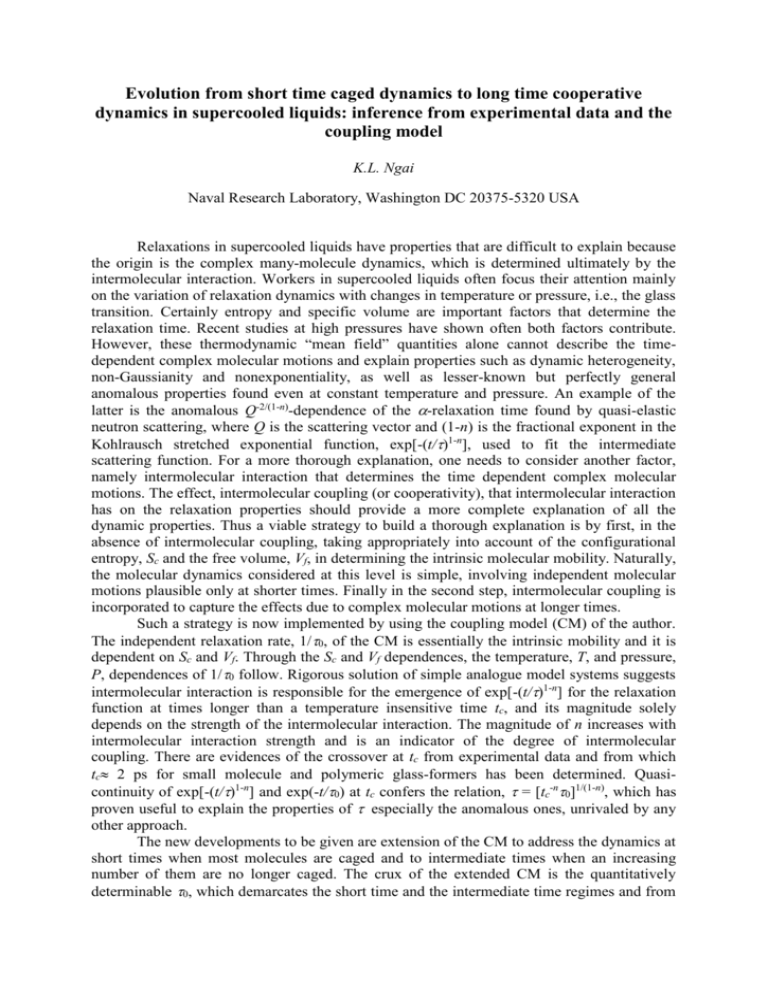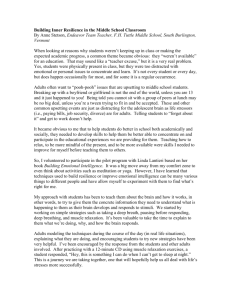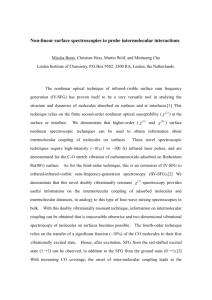Abstract, 26 kB, Word 97
advertisement

Evolution from short time caged dynamics to long time cooperative dynamics in supercooled liquids: inference from experimental data and the coupling model K.L. Ngai Naval Research Laboratory, Washington DC 20375-5320 USA Relaxations in supercooled liquids have properties that are difficult to explain because the origin is the complex many-molecule dynamics, which is determined ultimately by the intermolecular interaction. Workers in supercooled liquids often focus their attention mainly on the variation of relaxation dynamics with changes in temperature or pressure, i.e., the glass transition. Certainly entropy and specific volume are important factors that determine the relaxation time. Recent studies at high pressures have shown often both factors contribute. However, these thermodynamic “mean field” quantities alone cannot describe the timedependent complex molecular motions and explain properties such as dynamic heterogeneity, non-Gaussianity and nonexponentiality, as well as lesser-known but perfectly general anomalous properties found even at constant temperature and pressure. An example of the latter is the anomalous Q-2/(1-n)-dependence of the -relaxation time found by quasi-elastic neutron scattering, where Q is the scattering vector and (1-n) is the fractional exponent in the Kohlrausch stretched exponential function, exp[-(t/)1-n], used to fit the intermediate scattering function. For a more thorough explanation, one needs to consider another factor, namely intermolecular interaction that determines the time dependent complex molecular motions. The effect, intermolecular coupling (or cooperativity), that intermolecular interaction has on the relaxation properties should provide a more complete explanation of all the dynamic properties. Thus a viable strategy to build a thorough explanation is by first, in the absence of intermolecular coupling, taking appropriately into account of the configurational entropy, Sc and the free volume, Vf, in determining the intrinsic molecular mobility. Naturally, the molecular dynamics considered at this level is simple, involving independent molecular motions plausible only at shorter times. Finally in the second step, intermolecular coupling is incorporated to capture the effects due to complex molecular motions at longer times. Such a strategy is now implemented by using the coupling model (CM) of the author. The independent relaxation rate, 1/0, of the CM is essentially the intrinsic mobility and it is dependent on Sc and Vf. Through the Sc and Vf dependences, the temperature, T, and pressure, P, dependences of 1/0 follow. Rigorous solution of simple analogue model systems suggests intermolecular interaction is responsible for the emergence of exp[-(t/)1-n] for the relaxation function at times longer than a temperature insensitive time tc, and its magnitude solely depends on the strength of the intermolecular interaction. The magnitude of n increases with intermolecular interaction strength and is an indicator of the degree of intermolecular coupling. There are evidences of the crossover at tc from experimental data and from which tc 2 ps for small molecule and polymeric glass-formers has been determined. Quasicontinuity of exp[-(t/)1-n] and exp(-t/0) at tc confers the relation, = [tc-n0]1/(1-n), which has proven useful to explain the properties of especially the anomalous ones, unrivaled by any other approach. The new developments to be given are extension of the CM to address the dynamics at short times when most molecules are caged and to intermediate times when an increasing number of them are no longer caged. The crux of the extended CM is the quantitatively determinable 0, which demarcates the short time and the intermediate time regimes and from which the characteristics of the dynamics in the short and intermediate-times regimes can be inferred. In many supercooled liquids, at temperatures above Tg, the “universal” JohariGoldstein (JG) -relaxation time, JG, is found nearly coincident with 0. These findings give physical reality to the independent relaxation time of the CM through the JG relaxation time, and validate its nature of a local independent relaxation. Several experimental facts indicate that the JG relaxation, and hence the independent relaxation of the CM, is a function of entropy and volume. These include the non-Arrhenius temperature dependences above Tg and pressure dependence of JG, and the relatively abrupt increase of the derivative of the dielectric strength of the JG relaxation, (dJG/dT), at Tg like the thermal expansion coefficient and the heat capacity of a glass. In the short time regime, t<<0JG, most of the molecules are caged and the low probability of independent relaxation give rise to the “near constant loss” (NCL). There are experimental evidences of the NCL from broadband dielectric relaxation measurements and dynamics light scattering experiment at temperatures above Tg. In glass-formers with weaker intermolecular coupling and at temperatures near Tg, the NCL has been observed over many decades of frequency. The intensity of the NCL, NCL”, increases monotonically with temperature but with different rates below and above Tg. There is again a relatively abrupt increase of the derivative, (dNCL”/dT), at Tg like the thermal expansion coefficient and the heat capacity of a glass. These properties are explained by the extended CM. The near constant loss can be detected by elastic scan of neutron scattering with high energy resolution like 1 eV in the form of the so-called “fast relaxation”, which is expressed as a factor, exp[-Q2<u2(T)>/3], in the incoherent scattering law. Here <u2(T)> is the mean square displacement. There is an observed change of rate of increase of <u2(T)> with T at Tg, a previously puzzling result, and now can be explained by the extended coupling model through the property of the NCL.







